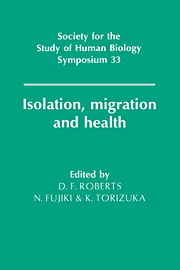Book contents
- Frontmatter
- Contents
- List of contributors
- Preface
- 1 The legacy of the IBP: Presidential Address
- 2 The distinction between primary and secondary isolates
- 3 Time trends in the break-up of isolates
- 4 Factors influencing the frequency of consanguineous marriages in Japan
- 5 Break-up of isolates
- 6 Isolates in India: their origin and characterisation
- 7 Consanguineous marriages and their genetical consequences in some Indian populations
- 8 Biomedical and immunogenetic variation in isolated populations in India
- 9 Genetic distance analyses in Israeli groups using classical markers and DNA polymorphisms in the β globin gene
- 10 Non-random distribution of Gm haplotypes in northern Siberia
- 11 Allele frequency estimation
- 12 Genetic affinities of human populations
- 13 Inherited neurological diseases in island isolates in southern Japan
- 14 Serological and virological evidence for human T-lymphotropic virus type I infection among the isolated Hagahai of Papua New Guinea
- 15 Analysis of genes associated with hypercholesterolaemia in the Japanese population
- 16 Migrant studies and their problems
- 17 Tokelau: migration and health in a small Polynesian society - a longitudinal study
- 18 Micromigrations of isolated Tuareg tribes of the Sahara Desert
- 19 Population structure in the eastern Adriatic: the influence of historical processes, migration patterns, isolation and ecological pressures, and their interaction
- 20 Diabetes and diabetic macroangiopathy in Japanese-Americans
- 21 Diabetes and westernisation in Japanese migrants
- 22 Environmental factors affecting ischemic heart disease
- Epilogue
- Index
Epilogue
Published online by Cambridge University Press: 05 March 2012
- Frontmatter
- Contents
- List of contributors
- Preface
- 1 The legacy of the IBP: Presidential Address
- 2 The distinction between primary and secondary isolates
- 3 Time trends in the break-up of isolates
- 4 Factors influencing the frequency of consanguineous marriages in Japan
- 5 Break-up of isolates
- 6 Isolates in India: their origin and characterisation
- 7 Consanguineous marriages and their genetical consequences in some Indian populations
- 8 Biomedical and immunogenetic variation in isolated populations in India
- 9 Genetic distance analyses in Israeli groups using classical markers and DNA polymorphisms in the β globin gene
- 10 Non-random distribution of Gm haplotypes in northern Siberia
- 11 Allele frequency estimation
- 12 Genetic affinities of human populations
- 13 Inherited neurological diseases in island isolates in southern Japan
- 14 Serological and virological evidence for human T-lymphotropic virus type I infection among the isolated Hagahai of Papua New Guinea
- 15 Analysis of genes associated with hypercholesterolaemia in the Japanese population
- 16 Migrant studies and their problems
- 17 Tokelau: migration and health in a small Polynesian society - a longitudinal study
- 18 Micromigrations of isolated Tuareg tribes of the Sahara Desert
- 19 Population structure in the eastern Adriatic: the influence of historical processes, migration patterns, isolation and ecological pressures, and their interaction
- 20 Diabetes and diabetic macroangiopathy in Japanese-Americans
- 21 Diabetes and westernisation in Japanese migrants
- 22 Environmental factors affecting ischemic heart disease
- Epilogue
- Index
Summary
The foregoing pages concern the opposing processes of isolation and migration. In isolation a population maintains itself in (usually) a relatively constant environment, its gene pool remains unadulterated from outside, it evolves under the influences of natural selection, mutation, genetic drift and other random processes, and experiences internal changes in its genetic structure. Migration exposes the migrants to environmental change, so that comparison with those in the same population who did not migrate and are presumed to be of the same genetic constitution demonstrates the effect of change of environment, and so helps to separate out the genetic and environmental components of biological variation. This book aims to illustrate the biological effects of the two processes, to show how the situations to which they give rise may be used to elucidate a variety of biological problems ranging from evolutionary change to disease etiology. This object is achieved by a number of examples, the majority of which have been studied by Asian investigators and are less widely known than the classic Western studies of say the Amish, Yanomama or the Aland islanders (e.g. McKusick, 1978; Neel & Weiss, 1975; Eriksson, 1980). Besides documenting the results, the chapters illustrate the different methods employed in such studies.
Isolates
Isolation comes about or is maintained in many ways, and isolating factors include geographical barriers, distance, religious differences, hostility, mating patterns and other social and cultural variables (Roberts, 1975, 1984). The term isolate is used in many ways, ranging from the conceptual circle of marriages within an otherwise continuous population envisaged by Dahlberg (1929) to the small reproductively sequestered island populations where breeding and geographical boundaries coincide and are virtually absolute.
- Type
- Chapter
- Information
- Isolation, Migration and Health , pp. 249 - 256Publisher: Cambridge University PressPrint publication year: 1992

